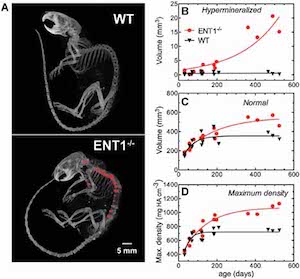A novel mouse model of Diffuse Idiopathic Skeletal Hyperostosis (DISH)
This research is based on the observation that mice lacking the gene encoding the equilibrative nucleoside transporter 1 (ENT1), demonstrate hypermineralized spinal lesions with remarkable resemblance to diffuse idiopathic skeletal hyperostosis (DISH). The Arthritis Society lists DISH as the second most common form of arthritis after osteoarthritis. The etiology of DISH is unknown and consequently there are no specific treatments. The goal of this project is to determine the mechanism underlying mineralization of spinal tissues following loss of ENT1. Our research to date has combined histological and high resolution microCT imaging with molecular characterization to investigate the link between loss of ENT1 function and development of DISH (Warraich et al. J Bone & Mineral Research).
We have generated intriguing new data linking deregulation of adenosine signalling with the induction of mineralization in specific cell types, exciting ongoing studies.


